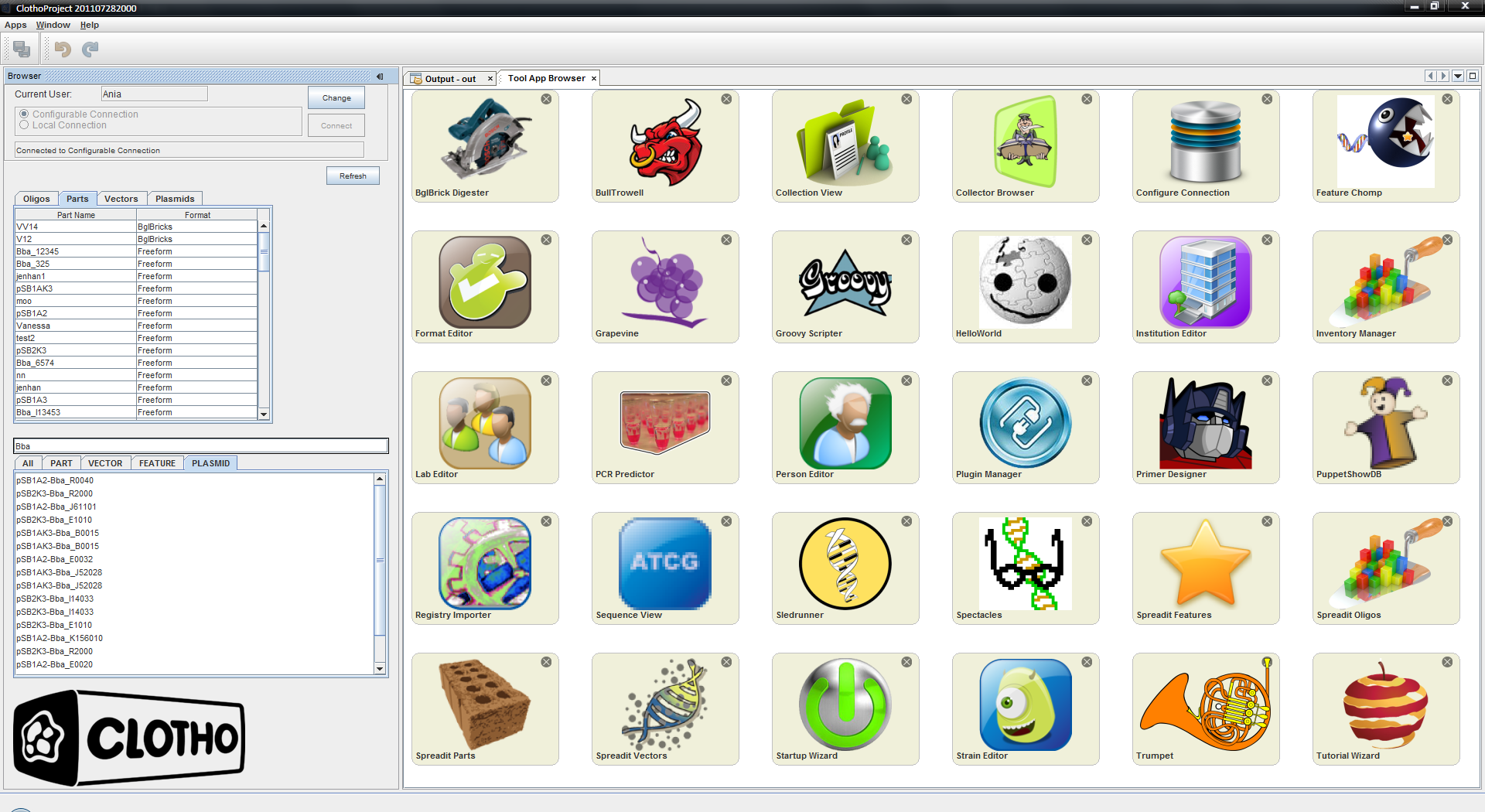Team:BU Wellesley Software/Clotho
From 2011.igem.org
Clotho
Tool Overview
Clotho is a software platform for synthetic biologists. Clotho is a nexus. Clotho is the foundation for the automated future of biological engineering. All of these feats are accomplished without Clotho doing anything itself. At its core, Clotho is a data model and a plugin infrastructure. In other words, Clotho gives a vocabulary to describe biological objects and a way for many different types of tools to interact with these biological objects. By itself, Clotho is not a tool. However, the plugin infrastructure allows Clotho to be a rallying points for all sorts of different tools, each fulfilling the exact need of the user. Clotho is highly adaptable, and will rise to meet the diverse challenges that will need to be met in synthetic biology.
This summer we built a large variety of tools. We built a tool that designed re-configurable plasmids for studying tuberculosis. We created a software suite for performing automated software assembly. We also made a primer designing tool,Genbank parsing tool, a tool for viewing sequence annotations. And we redesigned the interface to make Clotho easier to use and more effective as a tool for researchers. All of these tools can interact seamlessly with the same data. Clotho is the converging point for the tools we have made at Boston University, as well as those being developed at Johns Hopkins University, UC Berkeley, and tools we have not even dreamed up yet.
Each of these tools are designed to make it easier for scientists to manage their data and generate results. There will be no more spreadsheets, no more copy and pasting sequences in a text editor. You can simulate pcr amplification, simulate insertion into a vector backbone, and then annotate that plasmid, all with the same software tool, without having to open half a dozen windows. Drag a part and drop it according to your intuition. This summer at Boston University we built software tools that helped wet lab scientists interact with their data in novel ways that produced results. Each member of the wetlab here at Boston University, used Clotho on a day to day basis to manage their data and to design their constructs. Using feedback from the wet lab, we iterated towards creating optimal tools. By using Clotho, the wet lab delivered faster and more accurate results. We hope that Clotho can prove to be a similar boon to labs across the country and around the world. Clotho is the most developed open-source software platform designed specifically for synthetic biologists by bioengineers, electrical engineers, computer scientists, and a diverse spectrum of innovative thinkers.

 |
Results
Clotho allows one to enter a variety of pieces of DNA including promoters, RBS, genes, and terminators into a database and then electronically form plasmids out of them. Besides pieces like the promoters which are considered parts in Clotho, the backbones can be saved as vectors and can be changed up in creating the plasmids. BullTrowel, Spreadit Parts, Spreadit Vectors, and Spreadit Features are a suite of tools that enable one to enter the parts, vectors, plasmids, and features into the database.
An example of a collection showing parts, vectors, and features
Collector Browser provides a way to view the library of everything already entered that allowed us to check out what parts were available to form a plasmid. Additionally, parts could be entered as features. In Sequence Viewer, features are highlighted to enable us to know where such things as restriction enzymes are in a plasmid. Once Clotho helped us to maximize the design of our plasmids, we then set out to physically construct them.
A DNA sequence opened in sequence viewer with features highlighted.
Demo Video
Future Work
More applications- Clotho is only as powerful as the applications that utilize the data model and the Clotho infrastructure. The proliferation of new Clotho applications will further Clotho's maturity and capability. Clotho's plugin architecture is optimal for collaboration in the community. Individual labs may continue to develop their specially tailored software and then disseminate those portions they would like to share as a Clotho tool.
Increased automation- Clotho tools will begin to incorporate elements of high level design commonly found in more established engineering disciplines. Clotho tools such as Trumpet allow users to move further away from sequence level information. Users can begin to just describe the characteristics of their construct, and then software will take care of the rest.
Continued testing and refinement- Poor software is often the fault of lenient testing. Clotho is a platform built for synthetic biologists. The platform can only achieve continued refinement if there is a dialogue between programmers and users. These two parties need to realize each others capabilities and needs so that a powerful platform can be built. We hope that the current generation of bioengineers will embrace both disciplines and leverage both for the advancement of science.
 "
"
